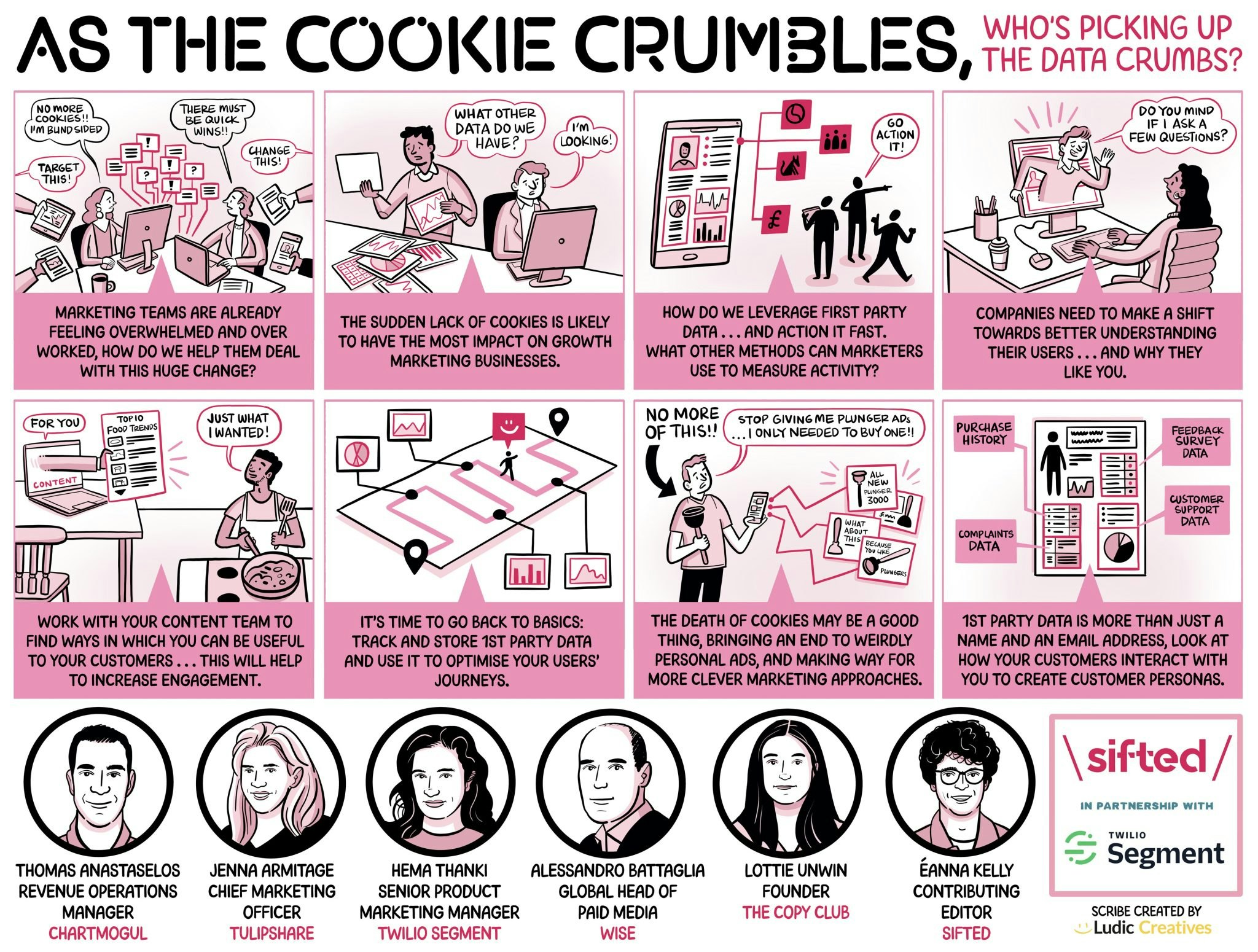Cookies — small files that websites put on your computer to store information about your preferences — are relied on by 81% of companies for marketing and growth, according to a recent report by Twilio.
But browsers, such as Google Chrome, plan to phase out cookies by 2024, reportedly to appease concerns from their audience.
Once the cookie crumbles, how can businesses acquire first-party data — and will it hinder growth?
In our latest Sifted Talks, we put these questions to our expert panel, which included:
- Thomas Anastaselos, revenue operations manager at subscription data platform ChartMogul
- Jenna Armitage, chief marketing officer at ethical investment platform Tulipshare
- Alessandro Battaglia, global head of paid media at fintech Wise
- Hema Thanki, senior product marketing manager at customer data platform Twilio Segment
- Lottie Unwin, founder of The Copy Club, a community for marketing professionals
Here’s what we learned:

1/ The majority of marketers feel unequipped
A lot of marketers, including herself, feel unequipped for a cookieless future, said Unwin. She said that the majority of marketing teams were already stretched — and another change in technology that rocks the foundation of their strategies would be unwelcome.
However, the panel agreed that growth marketing teams would have a better idea of the imminent upheaval to their advertising strategy — and other roles should rely on this expertise. Anastaselos estimated that most teams would need around six to twelve months to implement new processes.
“I can say on behalf of 1,200 members [of The Copy Club] that most of the members are coming into this completely blind with very little understanding of what's going on… Marketers have got big workloads, and our roles are already pretty stretched” — Lottie Unwin, The Copy Club
2/ Go back to basic principles
Armitage argued that cookies had become a crutch for lazy marketers. Rather than focusing on understanding their audience and tailoring content to solve specific pain points, easy access to third-party data has created a world where ads are served based on incomplete profiles, casting the net wide.
While collecting first-party data will take a shift in strategy, it can create a more engaged audience and reduce marketing spend, she added.
“By focusing on understanding why users like us, how we can make our product better and how we can communicate more to users’ needs, we drove results higher and our cost per acquisition has gone down significantly” — Jenna Armitage, Tulipshare
3/ Create helpful content to collect first-party data
The key difference between the current landscape and the cookieless future could lie in business’s ability to acquire first-party data. This means marketers will need to create value for their customers to then be able to serve them with further offers.
Thanki said that this would push for greater reliance on content marketers to provide high-value assets that can fill the top of the marketing funnel with quality leads.
“Think about ways you can add value to prospects, customers, people in the market… What is it that they don't know about a particular topic that we know, and start producing content around this and then use that as a lead capture” — Hema Thanki, Twilio Segment
4/ Acquire better-quality data for different personas
First-party data allows businesses to know more about their prospects and customers — and this data can be acquired through content marketing, as Thanki said, or through audience feedback forms and surveys.
Battaglia said this was key, especially for an international service like Wise. By going beyond basic information such as emails and phone numbers, he said that Wise had been able to tailor its communications for prospective and current customers based on their habits, location and where they are in their customer journey.
“Sometimes people think about first-party data as ‘Okay, I have an email address and a phone number’. But behind that email address and phone number, there is an individual that has been engaging with your business and you probably have much more data around their behaviour” — Alessandro Battaglia, Wise
5/ Be prepared to experiment
Once a company has started collecting first-party data, it can trial new ways of reaching its audience. Anastaselos said that once you had the raw data, marketing teams could play around with different media, track conversion and build up an ever-clearer persona of their target audience.
“Once you've got the raw data, you start iterating on the ways that you can combine that information. By doing that, you get more information on your audience and their user journeys, from lead to website or visitor to user” — Thomas Anastaselos, ChartMogul
6/ Respect user consent
While acquiring first-party data, organisations have to be careful for regulatory purposes as well earning the trust of their audience.
Battaglia suggested using a consent management tool for this, while Armitage said that trialling various points in the customer journey to decide when to ask for data could work well. It’s about making sure that users feel like they’re getting valuable content.
“We’re giving users a choice, and we have to respect it… Are you providing enough value for a user to be willing to engage with you over time?” — Battaglia
Like this and want more? Watch the full Sifted Talks here:


